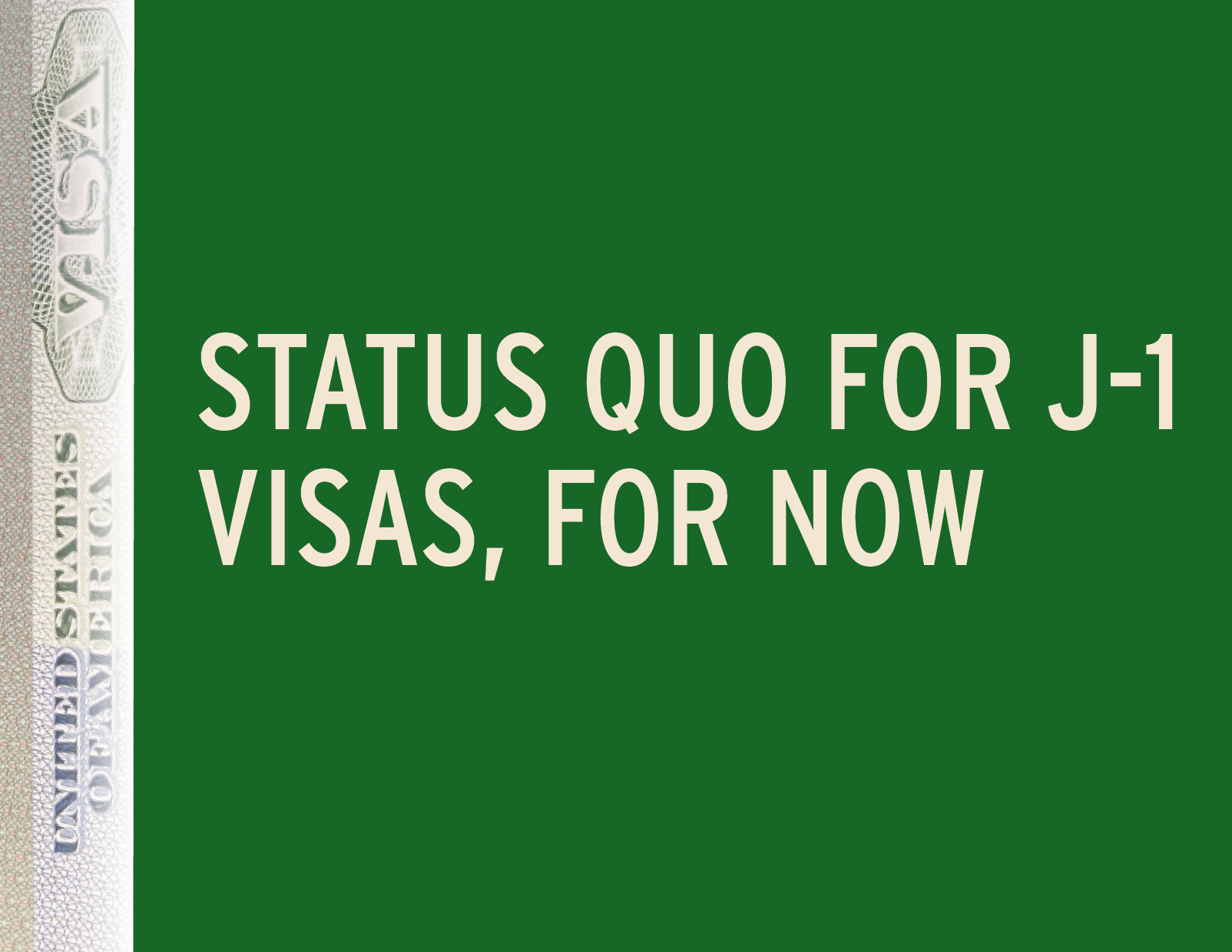Despite a new application process that requires J-1 seasonal workers to make their social media accounts public so authorities can review them for content that might be deemed hostile to the U.S., ski resorts report interest and participation in the program remained high heading into the all-important winter hiring season.
“We have not seen an impact yet. Our numbers are strong, plus a waitlist of students,” said Melinda Stearns, HR director at Sierra-at-Tahoe, Calif.
“We have had no drop in interest,” added Kate Sullivan, director of marketing and communications at Windham Mountain Club, N.Y., which typically hires 40-60 J-1s and will bring on 43 this winter. “The agency we work with is still seeing a high volume of applications and enthusiasm for employment.”
Ditto at Camelback, Pa., which hires a total of about 200 J-1s, summer and winter. “We are very fortunate to have them,” added Mary Popovich, VP of HR.
Brian Heon, general manager at Sunday River, Maine, concurred. “We have not seen a noticeable drop in interest or enthusiasm. Many of our returning team members stay in touch with us season to season. They typically support a range of departments, from mountain operations to food and beverage, and help us maintain a high level of service for our guests.”
The heightened scrutiny of J-1 applicants, which included a three-week pause in the program (that left many wondering if it would be available at all), is part of the Trump administration’s effort to weed out so-called “undesirable” immigrants. While the J-1 visa program is back up and running (for now), some are wondering about the future and how long it might be around. Many ski resorts and other seasonal businesses rely on the program to hire workers during peak business times.
A Matter of Time?
“We do anticipate challenges to the program throughout the Trump administration,” said Stearns at Sierra-at-Tahoe. “The program has been challenged a couple times in the past few years and, thankfully, has been maintained. We fear it’s only a matter of time, though, so coming up with Plans B, C and D is important right now.”
Stearns mentioned more emphasis on domestic recruiting and possibly in-country H-2B visa workers (that is, documented foreign workers who are already in the U.S.). The Trump administration has noticeably expanded the H-2B program. But Stearns said, “We’re not even trying for regular H-2Bs due to the October 1 start date.”
Reducing Reliance on J-1s
Taos Ski Valley, N.M., is already learning to live with fewer J-1 workers. From a high of roughly 100 J-1 employees in 2022-23, Taos has slowly cut its reliance on the program in half.
HR director Suzie Benton said the high-water mark was due largely to a local labor shortage as a result of the pandemic. “Since then, we have been slowly reducing our reliance on the J-1 program each year, down to about 50 this year where we would like to keep it.
“It’s not necessarily in response to the current administration or other challenges,” she added, “but more of a company initiative to further develop our local workforce and more year-round opportunities.
“The J-1 program is a fantastic cultural program,” Benton continued. “It was really made to create international partnerships, friendships. It’s what we want to use it for; not rely on it as necessary. Obviously, we do use J-1 workers because we need to use them, but we want to need them less.”
Interestingly, in an echo of what many businesses are saying about summer tourism—that international visitors have increasingly decided not to come to the U.S. this summer—Benton said Taos sent out 40 offers to previous J-1 workers for this winter. “Only 10 responded positively,” she said. “The other ones said they are not coming to the U.S.”
Typically, Benton said, “80 to 90 percent of responses are positive. We get most of them back. Not this year.”
Benton said Taos will still end up hiring about 50 J-1 workers for the coming ski season.
“We are in a unique, lucky spot with the strength of our local workforce. We already want to reduce our international numbers, and are taking advantage of this administration to help us do that.”
An Eye on the Future
Rachel Wessel, employee services manager at Brundage, Idaho, summed up the J-1 situation at many resorts: “We have not noticed any drop in participation or interest as we are preparing for winter 2025-26, but are paying close attention to ensure there aren’t going to be any interruptions or issues with the program coming to fruition this winter.” » cont.
“We’ll adapt to any regulatory changes as needed,” added Heon at Sunday River. “We will continue to review our seasonal staffing needs as we do each year, including both the J-1 and H-2B programs.”
Zero Tolerance of Harassment
Despite the popularity of the international student/worker program, workplace issues inevitably can arise, including harassment that might be directed at some of these workers from guests or even other staff. HR officials are adamant that harassment of any kind, directed at anyone, is not acceptable or tolerated.
“We have a zero tolerance harassment policy that applies to all guests and team members,” said Sullivan at Windham.
“We teach de-escalation for any type of situation,” added Popovich at Camelback. “It’s not just focused on international work and travel programs, but all types of situations.”
Same at Taos, said Benton. “We have very few, very isolated incidents between guests and staff. We stress de-escalation training and tools. I don’t think it’s a huge problem where we are. We are more concerned for our community at large, and have sent out resources of community partners and resources for our employees to take home and spread to their friends and families.”
J-1s: Cultural and Labor Values
Whatever the future of the J-1 program, there is no denying its value, both as an important source of short-term laborers and a way to break down barriers and deepen cultural understanding among people from all over the world.
“We value the cultural exchange that happens across our resort and appreciate the diverse perspectives and experiences our J-1 and H-2B team members bring to the mountain,” Heon said.
“Aside from filling a labor gap that cannot be filled locally,” agreed Sullivan, “our J-1 participants bring the vibrancy of their various cultures to our community. As soon-to-be young professionals in their respective industries, they contribute highly educated and service-oriented perspectives to the departments they work in, elevating our entire team and creating a global network of connections among our guests and domestic staff.”
At Camelback, Popovich said the value of the J-1 program is multi-faceted. “They help us to increase our staffing levels at peak times. Our local population is only so large. The J-1 program almost becomes a world-wide extension of our local population. We enjoy the opportunity to have a team as diverse as the guests we serve.”
“J-1s are great to have around,” Benton agreed. “They definitely bring a whole new facet to our work/life.”
What About Next Season?
The situation with J-1s could be quite different next season. The Trump administration’s budget proposal for fiscal 2026 imposes deep cuts to the State Department budget, including a 93 percent cut for the Bureau of Education and Cultural Affairs (ECA), which oversees the J-1 program. That would seriously limit the bureau’s ability to process visas.
However, it is Congress that sets the federal budget, and Congress typically makes its own budgetary decisions separate from the President’s budget request. Fortunately, the J-1 program has plenty of supporters in Congress, and even within the administration. Marco Rubio was a strong supporter while he was a Senator from Florida, which ranks third overall in states that use these special student visas, and he has continued to support the program as the Secretary of State.
National Ski Areas Association (NSAA) director of risk and regulatory affairs Dave Byrd told SAM that the association is individually lobbying members of Congress, especially Republicans and newly elected members. It is also joining other stakeholders outside the ski industry in lobbying Congress to keep the program fully funded and alive.
Further, NSAA plans to recruit Republican governors in ski states to send a letter of support for the program to Rubio, emphasizing how valuable the program is for businesses in their states and especially for rural economies.
Individual resorts can get involved, too, by contacting their senators and representatives to make sure they understand the program’s value and urging them to keep it and the ECA funded. Byrd stressed that congressional representatives and senators need to hear directly from ski areas themselves. “NSAA can assist and coordinate in that outreach,” he added.






